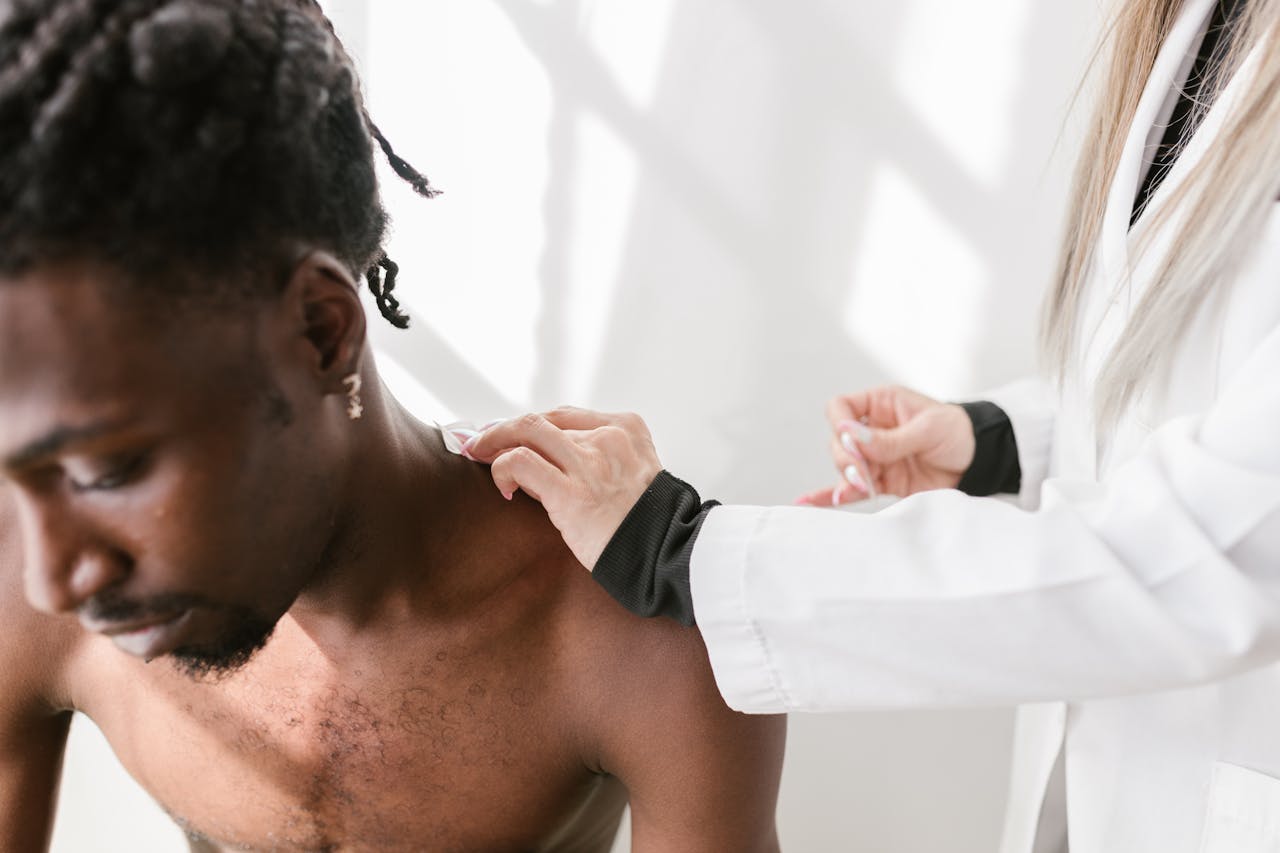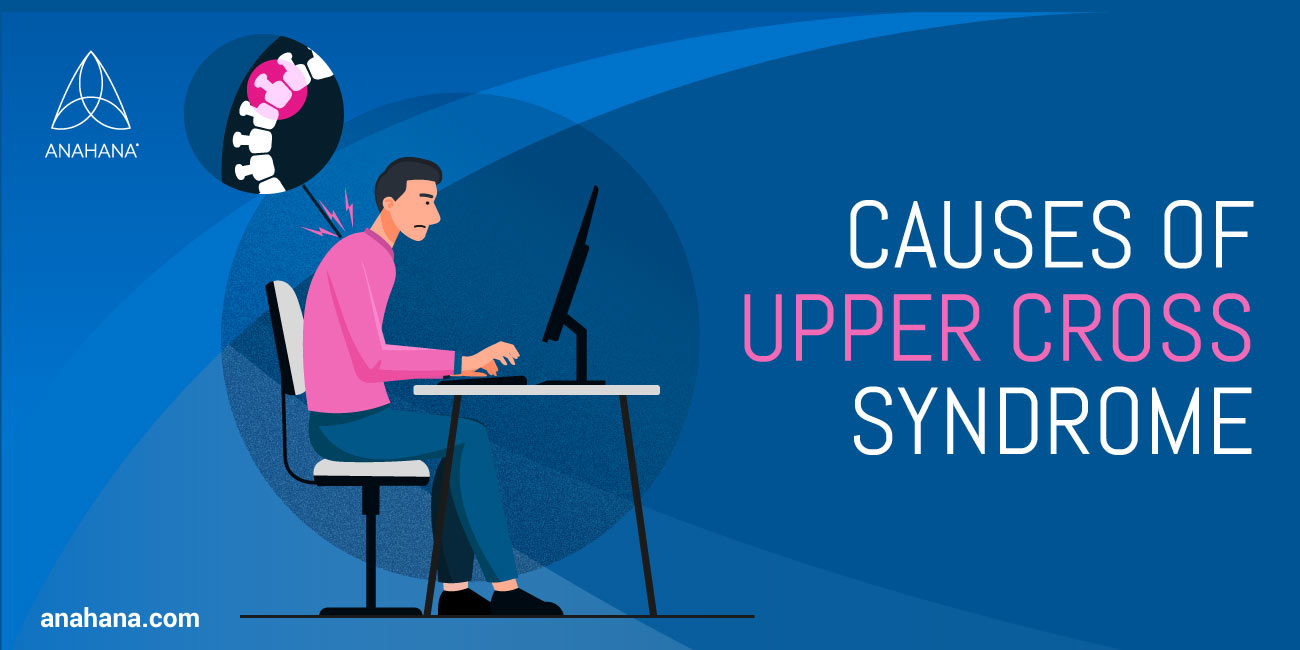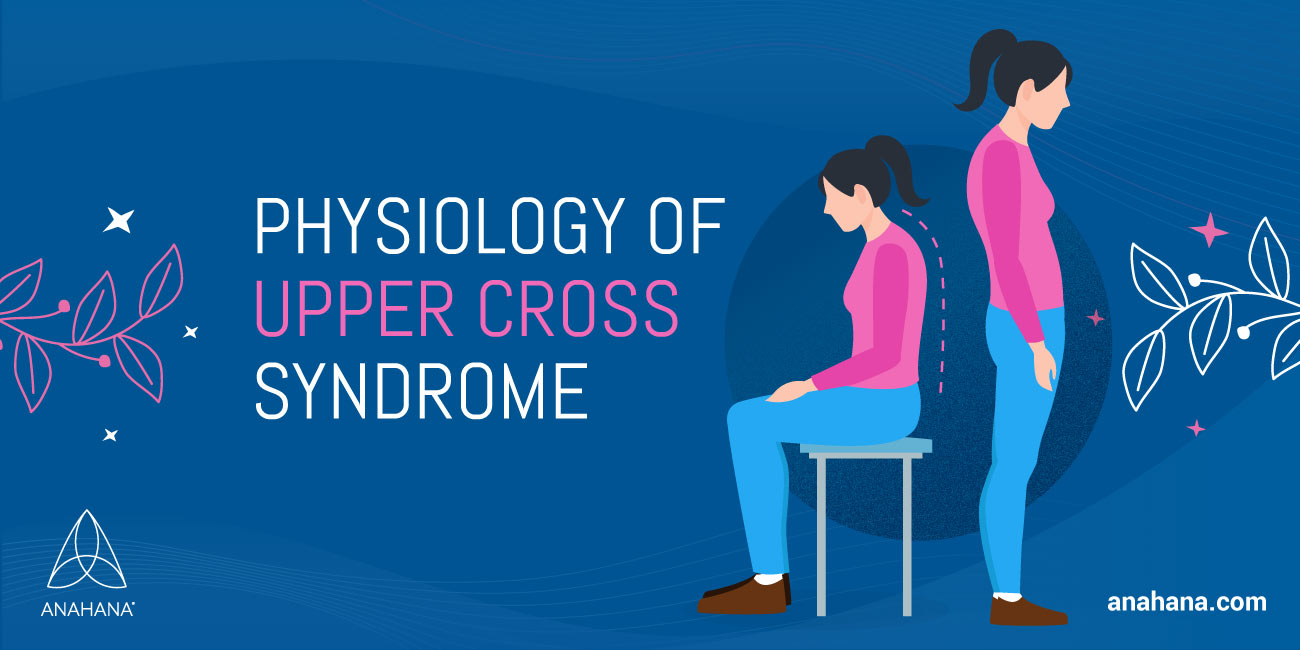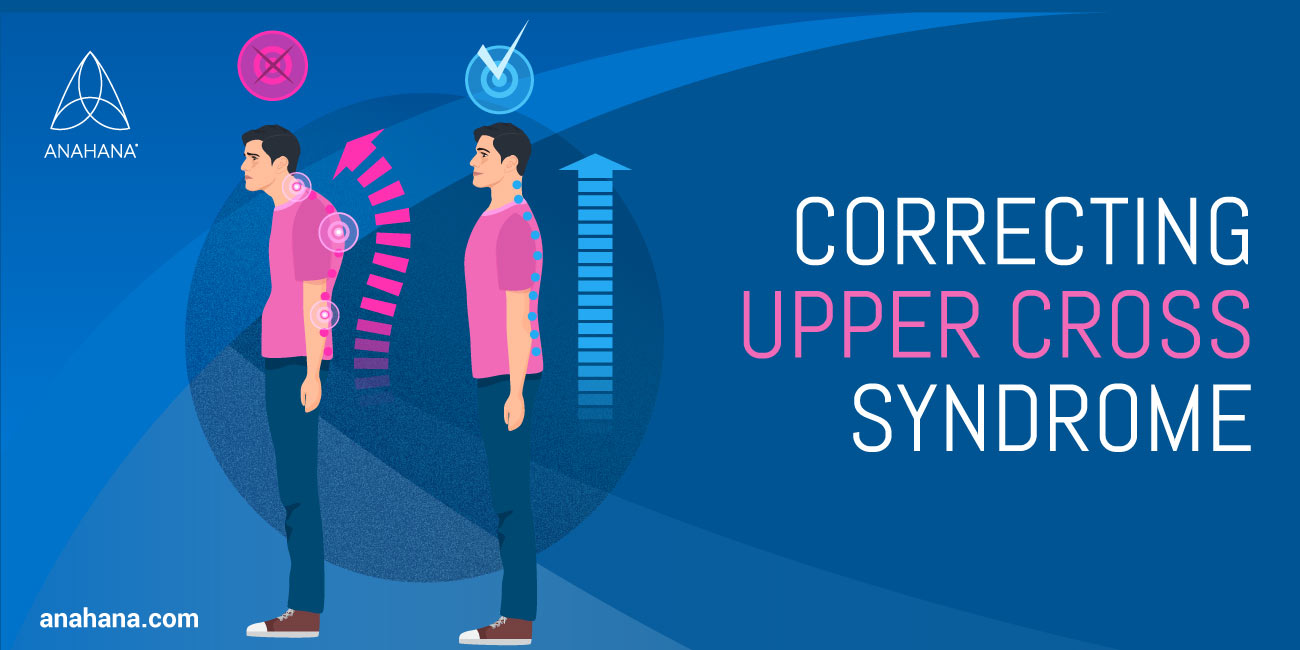
Table of Contents
Upper Cross Syndrome is a musculoskeletal disorder caused by muscular imbalances in the upper body. Upper Cross Syndrome can cause extreme muscle tightness, reduced range of motion, neck and shoulder pain, and headaches. Correcting Upper Cross Syndrome through stretching, strengthening, lifestyle changes, and professional intervention is possible.
Key Takeaways
- Definition: Upper Cross Syndrome (UCS) is a postural condition marked by forward head posture, rounded shoulders, and curved thoracic spine, often causing pain and joint dysfunction.
- Symptoms: Includes neck and shoulder pain, upper back pain, muscle tightness, reduced range of motion, and headaches.
- Causes: UCS results from muscular imbalances, often due to poor posture, lifestyle habits, overactive muscles, exercise imbalances, or injuries.
- Physiology: Involves imbalances in muscle pairs like the pectoralis major and latissimus dorsi, causing dysfunction.
- Correction: Stretching, strengthening exercises, ergonomic adjustments, proper posture, and professional treatment can alleviate UCS.
- Professional Help: Seeking professional advice is recommended for severe symptoms.
Definition of Upper Cross Syndrome
Upper cross syndrome, upper crossed syndrome, or UCS, is a postural condition characterized by an exaggerated forward head posture, rounded shoulders, and a curved thoracic spine. It can cause pain and joint dysfunction and is treatable at home and by specialists. It is classified, among other musculoskeletal disorders, as a repetitive strain injury.
Symptoms of Upper Cross Syndrome
Upper cross syndrome can have different symptoms depending on the severity of the condition. Rounded or protracted shoulders, protruding shoulder blades, decreased mobility, and a pronounced bent forward neck are the most identifiable symptoms of upper crossed syndrome. Less visible symptoms include neck pain, shoulder pain, upper back pain, extreme muscle tightness, especially in the upper back and shoulder muscles, a reduced range of motion, and headaches. Some or all symptoms may be present, with more painful symptoms usually developing over extended periods.
Causes of Upper Cross Syndrome
 A muscular imbalance in the upper body causes upper cross syndrome. Weak or underactive mid-back muscles lack the strength to counteract muscle tightness and shortened muscles in the neck and front of the body. From a side view, muscles form an “X” shape, or cross, from the chin to the shoulders and upper trapezius to the pectorals. One arm of the cross is overly tight, and the other is too weak to counteract the tightness.
A muscular imbalance in the upper body causes upper cross syndrome. Weak or underactive mid-back muscles lack the strength to counteract muscle tightness and shortened muscles in the neck and front of the body. From a side view, muscles form an “X” shape, or cross, from the chin to the shoulders and upper trapezius to the pectorals. One arm of the cross is overly tight, and the other is too weak to counteract the tightness.
Postural Factors
Chronic poor posture is the most common cause of upper cross syndrome. Muscles adapt to the positions where they are most frequently used, meaning long periods spent in a hunched forward posture lead to shortened chest muscles and lengthened, weakened mid-back and shoulder muscles. Sitting or standing with prolonged poor posture will exaggerate this imbalance.
Lifestyle Factors
Work and leisure activities are often to blame for upper cross syndrome. Working on a computer, scrolling on a phone, assembly line work, and many other everyday activities require focusing on something in front of the body, below the head. It is easy to hunch or slouch forward when working in this position.
An Indian study looked at the prevalence of upper cross syndrome in laundry workers who spend hours in a forward head posture. They observed upper cross syndrome in over a quarter of the study’s participants. The primary identified cause was prolonged poor posture with the head forward and down, and the shoulders rolled forward. When possible, people should work to develop healthy postural habits while working and during leisure time to avoid developing or worsening the symptoms of upper cross syndrome.
Exercise and Fitness Factors
Much research shows that living an active life and working out contributes to overall health, but it is always possible to overdo it. Daneshmandi et al. looked at the postural health of 60 bodybuilders and 30 untrained individuals, investigating the occurrence of upper crossed syndrome. This study found a statistically significant increase in the symptoms of upper crossed syndrome in bodybuilders, likely tied to frequent and intense training of the anterior (front-of-body) muscles, neglect of the mid-and upper back muscles, and insufficient stretching.
Moreover, postural deficits consistent with upper cross syndrome were prevalent in volleyball players, swimmers, gymnasts, and pitchers. While exercise and sport are generally healthy, ensuring that one doesn't neglect certain muscle groups and that weakened muscles are specifically trained is impessentialnjury
Some injuries may lead to upper cross syndrome. Traumatic injuries can semi-permanently alter muscle length; damaged tendons or muscles generally heal in a shortened position, pulling the body into poor posture. Excessively stretched or torn muscles may heal longer than they should, exaggerating muscle imbalances and leading to musculoskeletal disorders, including upper cross syndrome.
Physiology of Upper Cross Syndrome
 The physiological cause of upper crossed syndrome is an inability of some muscles to counteract others, resulting in a muscle imbalance. Every muscle has another muscle to oppose it; this is called an agonist-antagonist pair. When any muscle flexes (the agonist), its antagonist relaxes. A simple example of an agonist-antagonist pair exists with the biceps and triceps. These muscles act on the same joint to provide movement at the elbow in different directions, with one always flexing and the other always relaxing.
The physiological cause of upper crossed syndrome is an inability of some muscles to counteract others, resulting in a muscle imbalance. Every muscle has another muscle to oppose it; this is called an agonist-antagonist pair. When any muscle flexes (the agonist), its antagonist relaxes. A simple example of an agonist-antagonist pair exists with the biceps and triceps. These muscles act on the same joint to provide movement at the elbow in different directions, with one always flexing and the other always relaxing.
The agonist-antagonist relationship is more complex in the neck and upper back. Still, the concept is the same: each muscle or muscle group has another muscle or muscle group to work against it, keeping it in healthy alignment. When an agonist is too strong, or its antagonist is too weak, it can result in joint dysfunction. In the case of the neck and upper back, this joint dysfunction is upper cross syndrome.
Muscle Imbalances
Imbalances in the agonist-antagonist pairs of the upper body lead to upper cross syndrome. Some of these muscle group pairs in the back, neck, chest, and shoulders include:
- Pectoralis major and latissimus dorsi
- Anterior deltoid and middle trapezius
- Serratus anterior and levator scapula
- Pectoralis major and lower trapezius
- Rhomboid major and rhomboid minor
Due to the multidirectional movement of the shoulders and neck, many muscles cross in different directions, making these agonist-antagonist pairs quite complex.
Tight Muscles
Muscles that are overworked or held in a shortened position, like upper cross syndrome, can become tight. Ironically, in upper cross syndrome, researchers have observed that the lengthened posterior muscles can tighten, too, further complicating the condition. These deformed muscles are often best remedied through stretching exercises, with static stretching being the most effective. The most commonly tight muscles in upper cross syndrome are the pectoral muscles, anterior neck muscles, upper trapezius, and levator scapulae.
Weak Muscles
Tight or overly-strong antagonists overpower weakened muscles. These muscles need strengthening to prevent upper cross syndrome symptoms from developing. The most common weak muscles responsible for upper cross syndrome include the deep neck flexors, serratus anterior, lower trapezius, and rhomboid.
Underactive Muscles
Muscles will shrink and lose strength if they are not used enough. For many people in modern life, the upper and mid back muscles and the posterior shoulder muscles do not see much use, making surrounding muscles work harder to compensate. Using muscle activation exercises for the underactive muscles responsible for upper cross syndrome will keep them strong and healthy, increasing the capability of maintaining good posture.
Correcting Upper Cross Syndrome
 Like most musculoskeletal system conditions, people can correct upper cross syndrome with some work and patience. Anyone can stretch tight, stiff muscles to alleviate tension, and they can strengthen weak or underactive muscles. A comprehensive corrective exercise program with stretching and strengthening can remedy the postural imbalances of upper cross syndrome.
Like most musculoskeletal system conditions, people can correct upper cross syndrome with some work and patience. Anyone can stretch tight, stiff muscles to alleviate tension, and they can strengthen weak or underactive muscles. A comprehensive corrective exercise program with stretching and strengthening can remedy the postural imbalances of upper cross syndrome.
Stretching
Inflexibility is a significant component of upper cross syndrome, so stretching exercises can help alleviate symptoms, improve flexibility, and correct muscle imbalances. Pectoralis major, anterior neck, levator scapulae, and upper trapezius stretching exercises can effectively relieve tension down the stiff arm of the “X.”
Strengthening
Weak muscles are the other major component of upper cross syndrome. Implementing corrective exercises aimed at strengthening those weak muscles is essential to ensure that good posture is maintained. A study by the Department of Physical Therapy at Walailak University, Thailand, showed significant improvements in upper crossed syndrome symptoms after four weeks of at-home shoulder blade squeeze exercises. Adding rhomboid, serratus anterior, neck flexor, and lower trapezius strength exercises to an exercise program will bring these lagging muscles up to par, improving upper crossed syndrome symptoms.
Ergonomic Adjustments and Lifestyle Changes
Finding a new career or discontinuing the hobbies that lead to upper crossed syndrome may not be reasonable, but some simple changes can make a big difference. Adjusting the height of a chair to prevent slouching, taking frequent breaks to stretch through a full range of motion, and focusing on good posture are simple changes that can have a massive impact.
Professional Treatment
Upper crossed syndrome can sometimes be very hard to correct without professional help. Soft tissue treatments like massage and physical therapy can be helpful to alleviate tension, and working with an exercise professional can strengthen weak muscles, improve whole body posture, and correct the faulty movement pattern causing issues. In more severe cases of upper crossed syndrome, seeking professional treatment is advised.
Frequently asked questions
How can I tell if I have upper crossed syndrome?
If you are experiencing some or all of the symptoms of upper crossed syndrome, the safest bet is to seek a medical professional’s opinion.
When should I seek professional treatment?
You should seek professional advice if you are experiencing neck pain, rounded shoulders, forward head posture, shoulder pain, or very tight upper trapezius muscles. If you notice a tingling sensation in the neck or upper back, frequent headaches, or decreased mobility at the shoulders and surrounding joints, you should seek help sooner than later.
Is upper crossed syndrome the same as poor posture?
Upper crossed syndrome is a postural condition that is a specific kind of poor posture. Posture involves the entire body, but upper crossed syndrome refers only to poor posture caused by a muscle imbalance in the “X” - the cross - in the upper body.
How can I correct my posture?
Bad posture is not a life sentence. A strengthening and stretching routine is effective for improving bad posture. One study showed a technique for remediation of upper crossed syndrome, including chin tuck, retraction of shoulders, and straightening the upper thoracic spine. An eight-week comprehensive program improved muscle tension and strength in participants compared to a control group.
Who does upper crossed syndrome effect?
Upper crossed syndrome is common in athletes, students, desk workers, and anyone who works in a bad posture position for long periods. Everyone is susceptible to upper crossed syndrome.
References
Upper Crossed Syndrome - Journal of the Australian Traditional-Medicine Society
Prevalence of Upper Cross Syndrome in Laundry Workers - PMC
Agonism and Antagonism of the Muscles of the Shoulder Joint: An SEMG Approach
Bodybuilding links to Upper Crossed Syndrome - Physical Activity Review

By: Anahana
The Anahana team of researchers, writers, topic experts, and computer scientists come together worldwide to create educational and practical wellbeing articles, courses, and technology. Experienced professionals in mental and physical health, meditation, yoga, pilates, and many other fields collaborate to make complex topics easy to understand. Anahana is also home to specialists in crystals, tarot, angel numbers, astrology, life path numbers, zodiac signs, and horoscopes. By combining evidence-based wellness with spiritual and energetic practices, the team offers clear, trustworthy guidance for both mind-body health and modern spirituality.